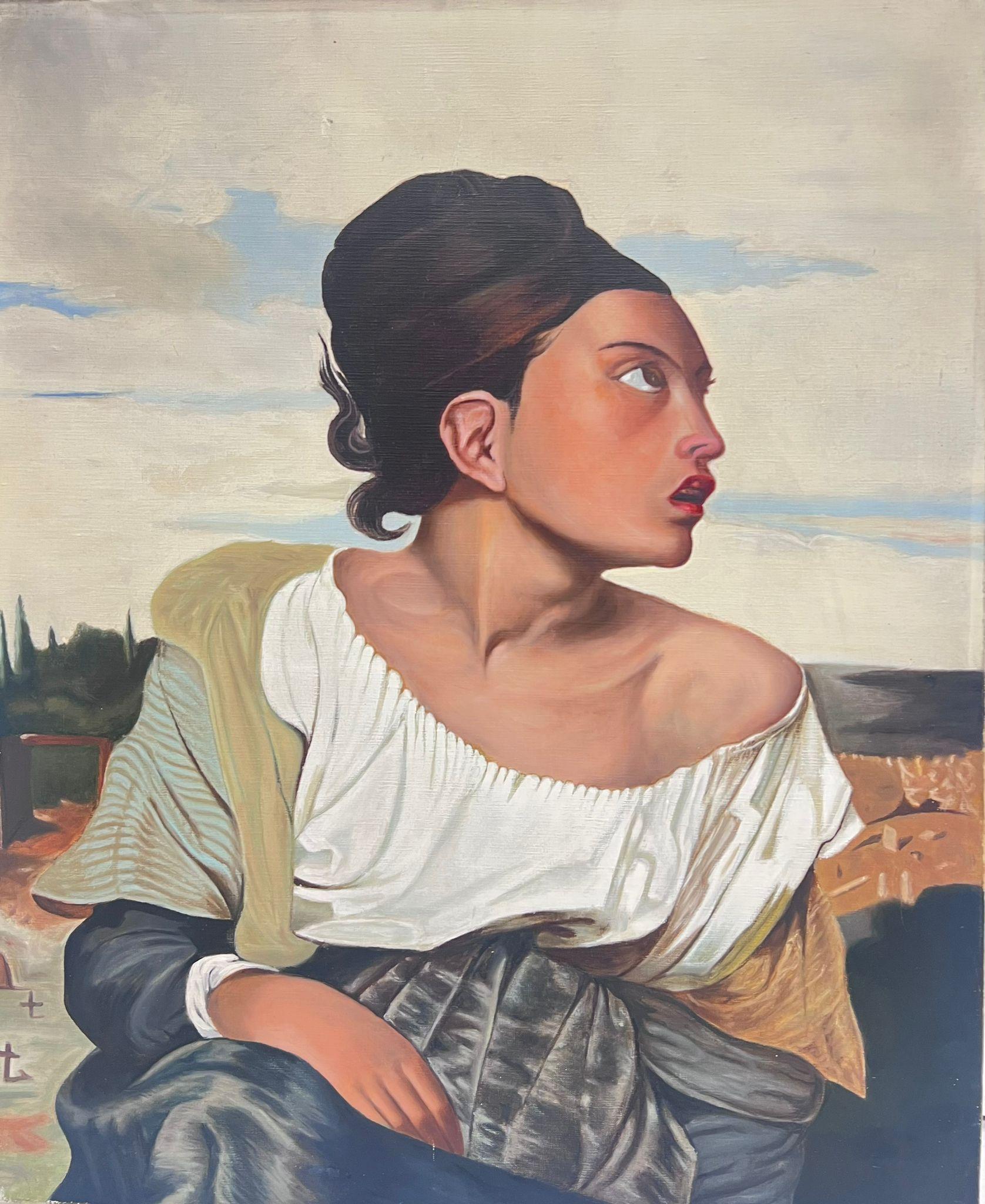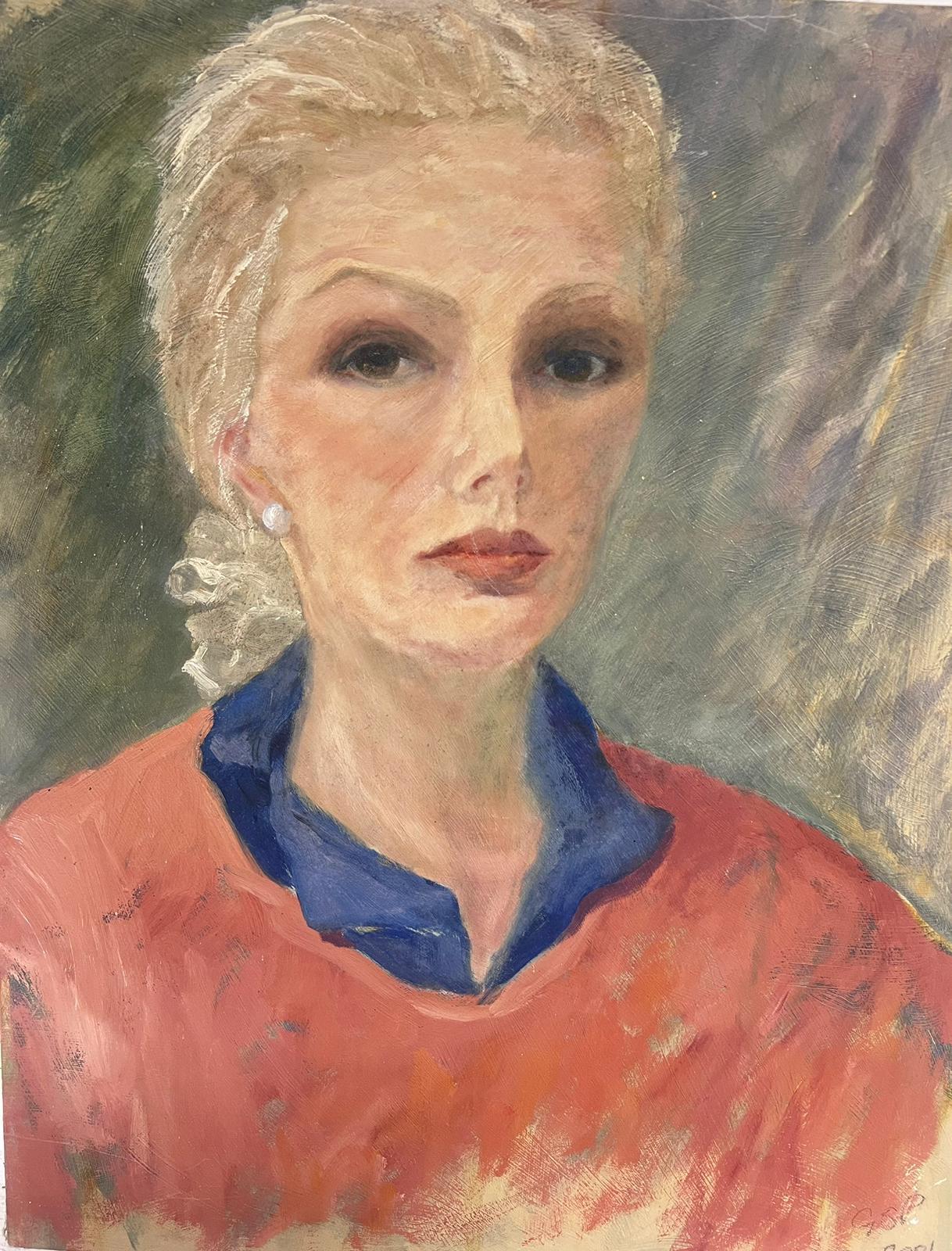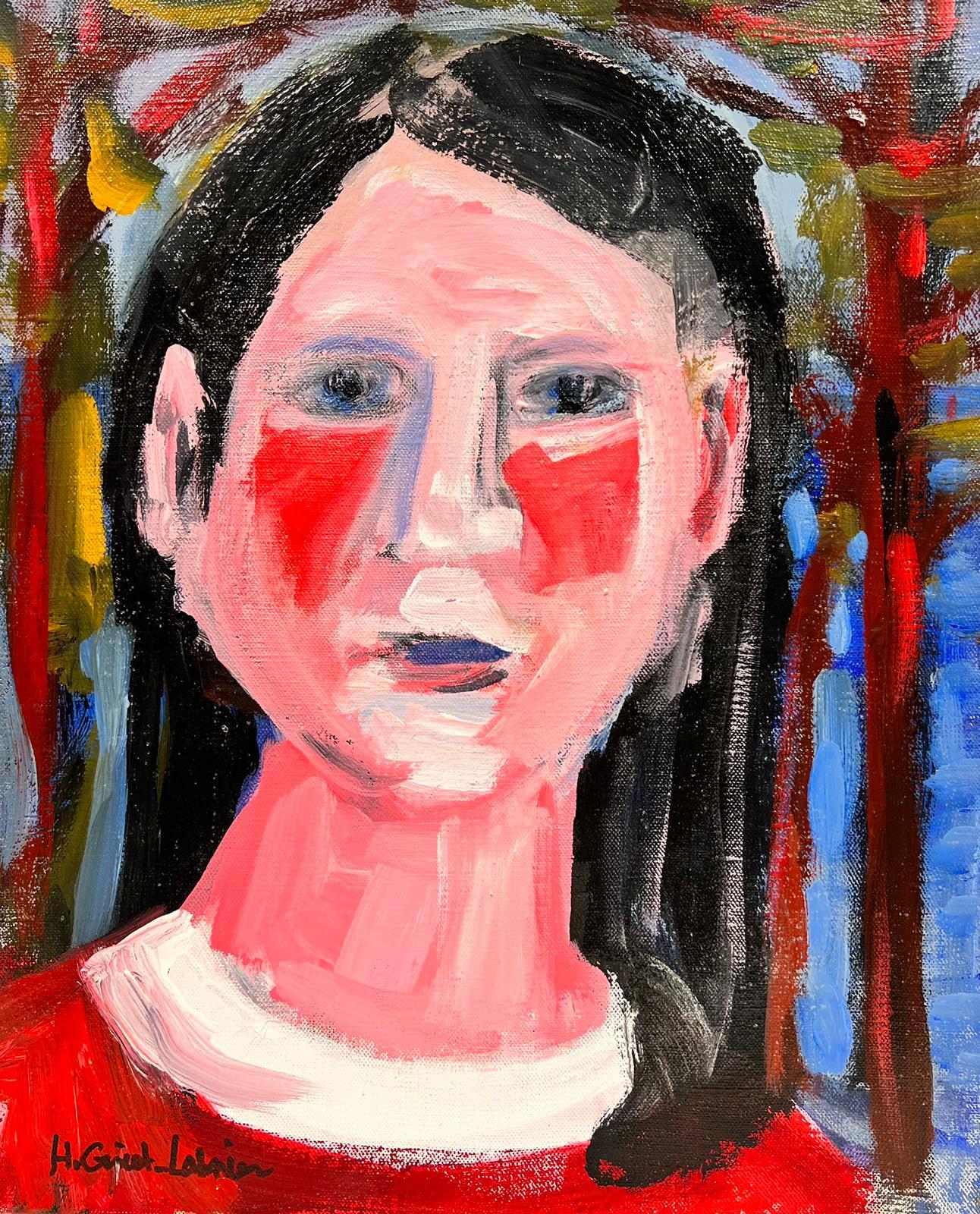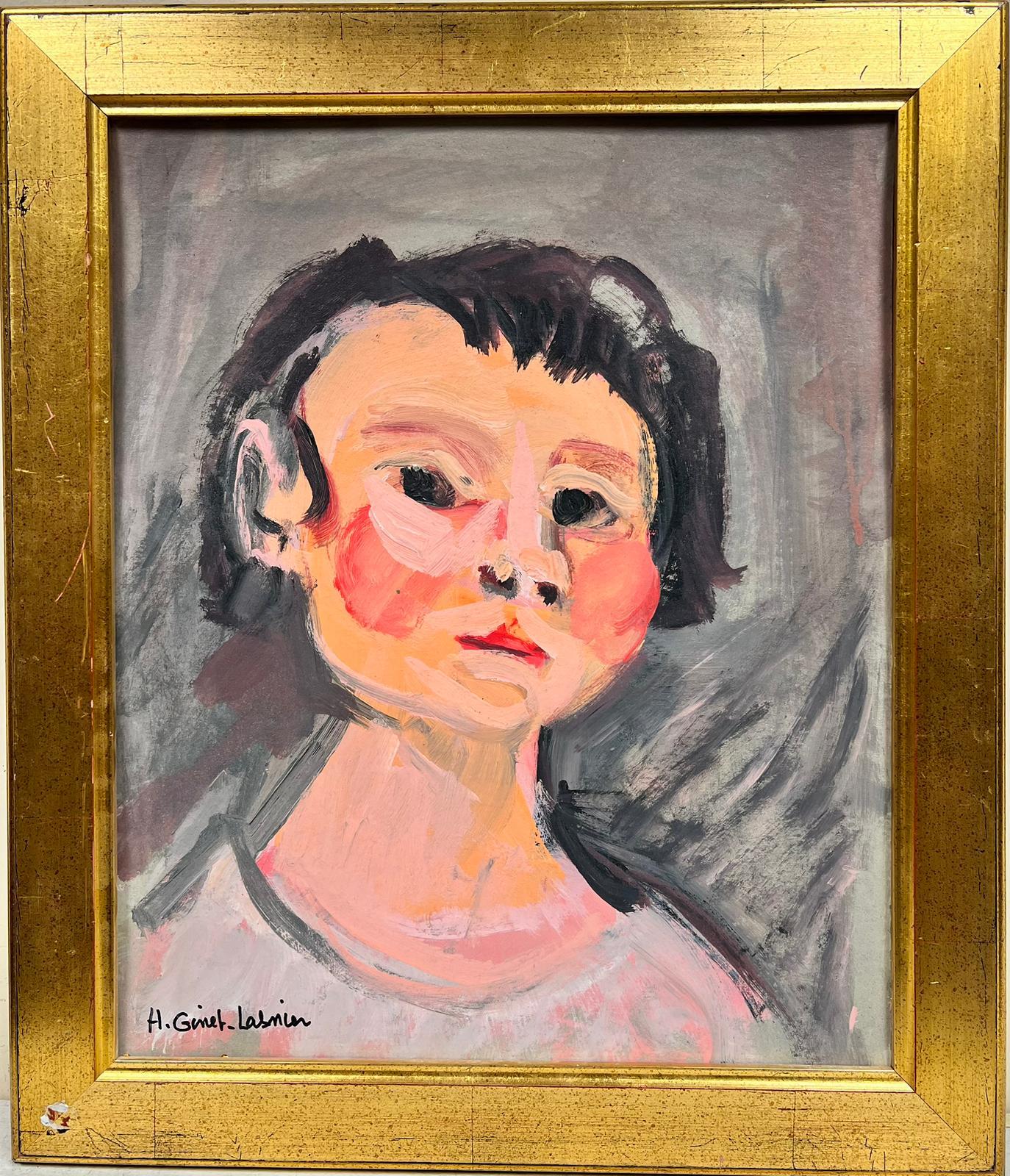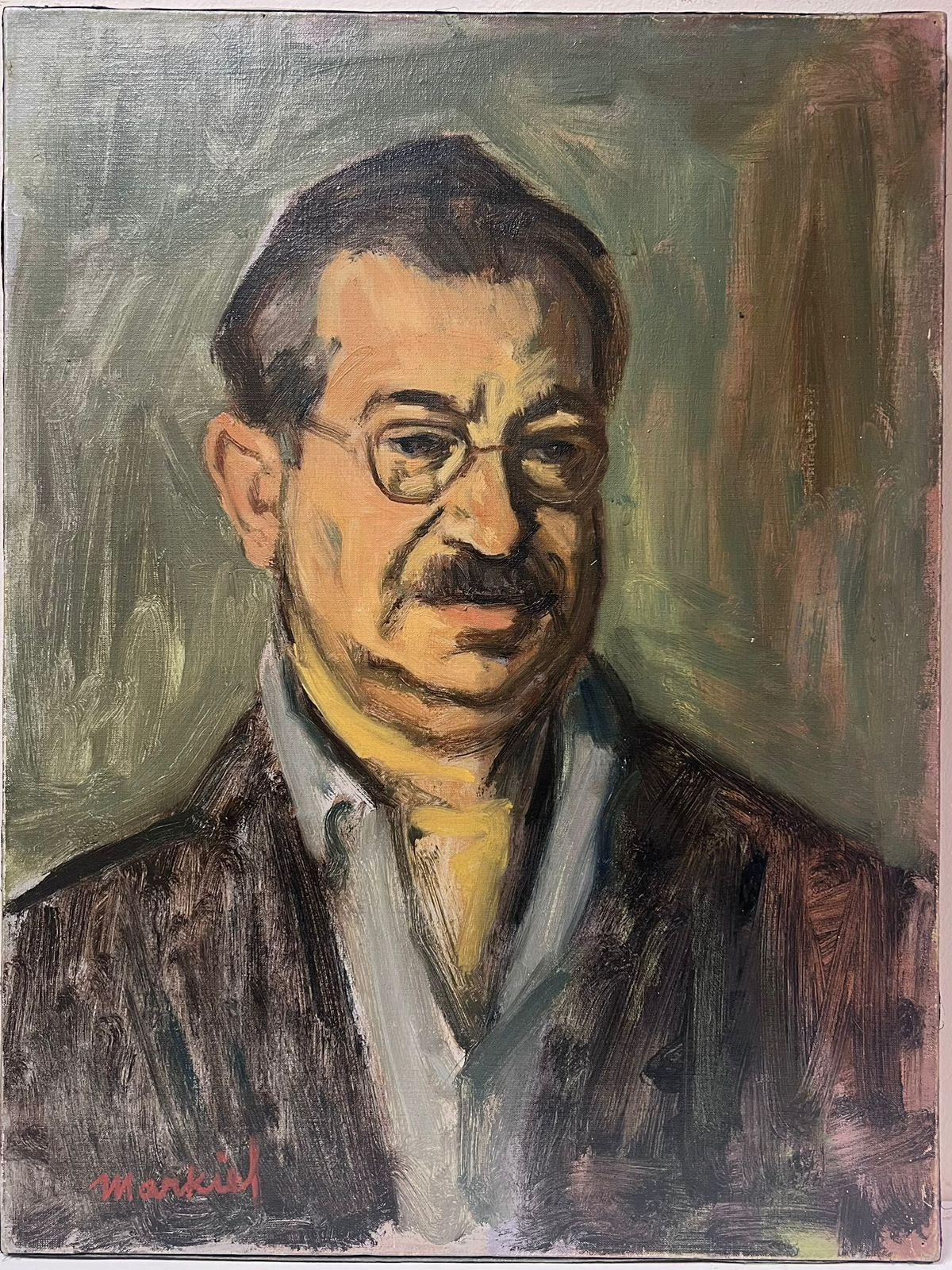Items Similar to Proud Chimney Sweep Modern Judaica Shtetl Oil Painting WPA Jewish artist
Want more images or videos?
Request additional images or videos from the seller
1 of 10
Maurice KishProud Chimney Sweep Modern Judaica Shtetl Oil Painting WPA Jewish artist
About the Item
Genre: Modern
Subject: Klezmer Musicians
Medium: Oil
Surface: Board, size includes artist decorated frame
Country: United States
The imagery of Maurice Kish (1895-1987), whether factories or carousels, reliably subverts expectations. His vision hovers just around the unraveling edge of things, where what is solid and clear becomes ambiguous. He is fascinated, often delighted, by the falling apart. This unexpected, fresh perspective results in oddly affecting pictures of a now long-gone New York.
Born Moishe in a town called Dvinsk, Russia (what is now Daugavpils, Latvia), Kish came with his family to New York when he was in his teens. The family settled in Brownsville, and for the rest of Kish’s life Brooklyn remained his home, though he moved from one neighborhood to another. He was close to his parents, who recognized his talent and supported his desire to become an artist.
Kish attended the National Academy of Design as well as Cooper Union. His fellow students included many other immigrants and children of immigrants who were particularly receptive to the Modernism coming from Europe. As his career progressed, Kish himself applied different strains of Modernism to different purposes. For him, the story was held above all else.
For years, Kish used the skills he acquired in art school to earn his living at a Manhattan glass factory where he painted floral designs on vases. During the Depression, Kish became a WPA painter in the Federal Art Project (FAP). FAP artists were given a mandate to create works that celebrated labor. The artists tended to be socially progressive, as Kish certainly was. Kish's work from this period, with its dark colors and rolling clouds, reveals the influence of Social Realists like Thomas Hart Benton. Apparent, too, is Kish's interest in the urban monumentality of Charles Sheeler. Kish's structures, however, lack Sheeler's almost dehumanized precision. Rather than the soulless, sleek machines of a typical modern urban dystopia, Kish's factories are shaggy old beasts as worn out as the laborers who troop through their doors. In End of Day's Toil, now at the Smithsonian, the viewer feels some affection for that rambly grandfather of a building all the tired small workers are leaving behind.
Much of Kish's work, for the FAP and elsewhere, undermines received truths in a similar way. Some early works with themes from Yiddish culture are overtly humorous: a painting of a big jolly wedding guest, looking invitingly over her shoulder; a Rabbi, a big fiddler on a small roof. Later, the humor becomes more ironic and reflective. In another work, the rather imposing organ grinder of the late 1930s looms above a child, yet his intermediary the cockatoo is bright and appealing, and offers the girl a fortune with his beak. This could read as an allegory for capitalism as easily as a straightforward colorful street scene. A small painting of a snowy day in Washington Square gives a bird's eye view of people bent against the wind walking alone or in pairs. The huge triumphal arch at the middle of it has no connection to their movements or their lives. Kish makes its size and centrality a quiet joke about the futility of grandiose gestures. Like the buildings in his FAP works, the arch has a personality. It is a landmark that looks a bit lost.
A favorite location for Kish was Coney Island. For the laborers of the city, this was a place of great freedom and possibility. There were no bosses! Anyone could go to ride the rides and swim in the sea. For Kish, Coney Island, and especially Luna Park, became a place richly symbolic of workers’ rights. For the dreamlike paintings he set there, Kish looked past the Social Realists to the Expressionists. His colors are brilliant and his lines are wild. These images, joyfully unrestrained, give full voice to an anarchic vision merely hinted at in other works. If the structures of the earlier pictures came further out of the background than expected, these Coney Island structures completely take over the scene.
Kish made several variations on the theme of the carousel as a site of revolution. In the moonlight, the horses have broken from their poles and spin away from the calm center. The workers have come to manic life, have released themselves from the yoke of labor and have abandoned their master, the merry-go-round. They escape to different corners of the pleasure park, dance together and ride the ferris wheel. One horse pretends to be a ticket seller. It is another allegory, one that depicts a worker's holiday paradise in carnival fashion.
A painter who embraced ambiguity, Kish was himself a man who occupied many worlds simultaneously. Even during the period when he had shows at prestigious galleries and belonged to several artists' groups, he identified most strongly as an outsider, a Yiddischer. He wrote poetry in Yiddish throughout his life. In 1968, he published a volume of fifty years of these poems, Di Velt ist Mayn Lid (The World is My Song) in Yiddish, with no English translation, for his peers. Kish also translated English-language poetry into Yiddish and acted as a guide to help other Yiddish writers. Long after the art organizations ceased to provide meaning and fulfillment, Kish was a devoted member of the Yiddish Culture Association.
In addition to painting and poetry, Kish was a dancer who taught during the summers at various Jewish resorts in the Catskills. Small but lithe, he also spent some years as an amateur boxer. Well into his eighties, Kish was proud of the quality of his handball game.
By the 1940s, Kish’s career was going well, but his descriptive style of working began to fall out of fashion, supplanted by a more formal Abstraction. Kish was never able to support himself solely through his art, yet in the midst of all of his other activities, Kish continued to create his distinctive images of an immigrant's New York. He departed far from the mainstream, and in later years, seldom showed his work, preferring to keep it for himself (although he sometimes traded paintings for rent).
Of making art, Kish said, "It is a sacred mission to enrich, to elevate and to make our lives more complete." His works, though frequently playful, encourage a second look at ordinary things. His irreverence elevates by revealing flaws where his audience, all workers and outsiders of a kind, can get a purchase. Kish's art fondly celebrates the beauty of the irregular.
- Creator:Maurice Kish (1895-1987, American)
- Dimensions:Height: 20.5 in (52.07 cm)Width: 16.5 in (41.91 cm)
- Medium:
- Movement & Style:
- Period:
- Condition:minor wear. minor varnish residue.
- Gallery Location:Surfside, FL
- Reference Number:1stDibs: LU38212767762
About the Seller
4.9
Platinum Seller
These expertly vetted sellers are 1stDibs' most experienced sellers and are rated highest by our customers.
Established in 1995
1stDibs seller since 2014
1,549 sales on 1stDibs
Typical response time: 1 hour
- ShippingRetrieving quote...Ships From: Surfside, FL
- Return PolicyA return for this item may be initiated within 3 days of delivery.
More From This SellerView All
- Holocaust Memorial Oil Painting Judaica Rabbi Composed of Figures Artists FrameBy Maurice NewmanLocated in Surfside, FLMaurice Newman was active/lived in Massachusetts / Lithuania. Maurice Newman is known for sculpture-abstraction, impressionist landscape painting, diorama. Born in Lithuania, Mauric...Category
1960s American Modern Portrait Paintings
MaterialsOil
- Dance of the In laws Wedding Scene Judaica Shtetl Oil Painting WPA Jewish ArtistBy Maurice KishLocated in Surfside, FLGenre: Modern Subject: Jewish Wedding Mechutanim Medium: Oil Surface: Board, size includes artist decorated frame Country: United States The imagery of Maurice Kish (1895-1987), whe...Category
Mid-20th Century Modern Figurative Paintings
MaterialsOil
- Modernist Oil Painting 1940s, Judaica Hasidic Rabbi in JerusalemBy Emanuel Glicenstein RomanoLocated in Surfside, FLGenre: Portrait Subject: Landscape Medium: Oil Surface: Board Country: United States EMANUEL ROMANO Rome, Italy, b. 1897, d. 1984 Emanuel Glicenstein Romano was born in Rome, September 23, 1897. His father Henryk Glicenstein was a sculptor and was living in Rome with his wife Helena (born Hirszenberg) when Emanuel was born. His father obtained Italian citizenship and adopted the name Enrico. Emanuel was brought up in Italy, Switzerland, Germany, England and Poland. In 1926 Emanuel and his father sailed for New York. They briefly visited Chicago. Romano's sister, Beatrice, and mother only joined them in New York years later. Romano changed his name on his arrival to America and some have erroneously speculated that this was to avoid antisemitic discrimination. In truth, as the son of a highly-regarded artist, Romano changed his name to ensure that any success or recognition he would later attain, would be the result of nothing other than his own merit as an artist, and not on account of his father's fame. In 1936 Romano was worked for the Federal Art Project creating murals. During and immediately after World War II, Romano created a series of allegorical works depicting graphic holocaust images that were held closely by the family until after his passing. One of these works is now on permanent display in the Florida Holocaust Museum in St. Petersburg Florida. Emanuel's father died in 1942 in a car accident before they could realize their shared dream of visiting Israel. In 1944 Romano, having completed his degree at the Pennsylvania Academy of Fine Arts and the Art Institute of Chicago, began teaching at the City College of New York. Romano moved to Safed, Israel in 1953 and established an art museum in his father's memory, the Glicentein Museum. COLLECTIONS Indianapolis Museum of Art Metropolitan Museum of Art Boston Fine Arts Museum Fogg Museum Musée Nacional de France Recently his work has been added to the Florida Holocaust Museum collection. His notable works include his holocaust themed allegorical paintings as well as portraits of Marianne Moore, his father and William Carlos Williams...Category
1970s American Modern Figurative Paintings
MaterialsOil, Board
- 1947 Expressionist Oil Painting Flute Player Musician Boris Deutsch WPA ArtistBy Boris DeutschLocated in Surfside, FLBoris Deutsch (American Lithuanian Russian, 1892-1978) "The Flute Player," 1947 Oil paint on canvas, Hand signed and dated upper left, Provenance: gallery label (Pasadena Art Museu...Category
1920s Modern Figurative Paintings
MaterialsCanvas, Oil
- The Preacher Rabbi "Der Maggid" Judaica Oil Painting WPA Jewish artistBy Maurice KishLocated in Surfside, FLGenre: Modern Subject: Hasidic Rabbi preaching in Synagogue Medium: Oil Surface: Board, size includes artist decorated frame Country: United States The imagery of Maurice Kish (189...Category
Mid-20th Century Modern Figurative Paintings
MaterialsOil, Board
- Oil Painting by Well Known Cartoonist and Illustrator Upper East Side, ManhattanBy Sandy HuffakerLocated in Surfside, FLAn Upper East Side of Manhattan New York city scene of bald guy reading newspaper on bench with East River and tugboat in background. The 1970s were the “glory days,” Huffaker says, for himself and a stable of talented illustrators whose work routinely found itself on the covers of the nation’s premier newsmagazines and in the pages of The New York Times. For the better part of that decade, Huffaker was among an elite breed of commercial artists—his hero and fellow Southerner Jack Davis, the legendary Mad Magazine illustrator, among them—working during a remarkable period when art directors routinely turned to illustration to give comic relief to the country’s deeply serious and dark problems. From civil rights and the women’s movement to Vietnam and Watergate, the gas crisis and inflation to the rise of Jimmy Carter, Huffaker mined a deep well of material ripe for his brand of visual wit and caustic satire. He sent his portfolio to children's book illustrator Maurice Sendak, the legendary “Where The Wild Things Are” illustrator to gauge his prospects, and when Sendak replied, “C’mon up, you’ll do all right,” SELECT HONORS: 2 Page-One Awards (from the New York Newspaper Guild), for work in Fortune Magazine and Sports Illustrated. Nominated 3 times for Cartoonist-of-the-Year by the National Cartoonists Society (illustration category). Desi Award of Excellence (Graphic Design Magazine). 20 Award of Merit citations from the Society of Illustrators. One-man show, Society of Illustrators. Illustrators 22 - annual national exhibition for the Society of Illustrators. SELECT MAGAZINE COVERS Time Magazine (6), Sports Illustrated (2), Business Week (12), Forbes, Saturday Review, New York Times Sunday Magazine, The New Republic, Family Weekly, Madison Avenue, New York Daily News Sunday Magazine (2), Junior Scholastic, ACLU, The Nation , and more EDUCATION BA, University of Alabama. Attended Pratt Graphic Center and The Art Students League, New York City. BOOKS WRITTEN AND ILLUSTRATED The Dispensible Man (M. Evans and Co.) and The Bald Book (M. Evans and Co.) BOOKS ILLUSTRATED White Is (Grove Press), The Begatting of a President (Ballantine Books), The Biggest Sneeze (Harper-Collins), H. Phillip Birdsong's ESP (Young Scott Books), Kids Letters to President Reagan (M. Evans), The Worlds Greatest Left-Handers (M. Evans), Does My Room Come Alive at Night (HarperCollins), The Man With Big Ears (HarperCollins), Jake Snake's Race (HarperCollins), and more POLITICAL CARTOONING Political cartoonist at The News and Obsever in Raleigh, NC and syndicated during the early 70's. Today, syndicated in 750 publications 3-times a week with Cagle Cartoons. FINE ART SHOWS Allied Artists of America, Salmagundi Club, Phillips Mill Annual (honorable mention), New Hope Shad Festival (grand Prize), Hunter Museum in Chattanooga ( one -man career retrospective), Santa Fe public library (one--man), Rosenfeld Gallery (Philadelphia), Potter...Category
20th Century American Modern Figurative Paintings
MaterialsCanvas, Oil
You May Also Like
- Portrait of a Man - Oil on Canvas by G. Bocchetti - Mid 20th CenturyBy Gaetano BocchettiLocated in Roma, ITPortrait of a Man is an original modern artwork realized the Italian artist Gaetano Bocchetti in the half of the XX Century. Hand-signed by the artist on teh lower left corner. Exc...Category
Mid-20th Century Modern Portrait Paintings
MaterialsCanvas, Oil
- 20th Century French Modernist Profile Portrait of a Lady Staring into the SkyLocated in Cirencester, GloucestershireStaring into Space French School, circa 1970's oil on canvas, unframed canvas: 18 x 15 inches provenance: private collection, France condition: very good and sound conditionCategory
Mid-20th Century Modern Portrait Paintings
MaterialsCanvas, Oil
- Contemporary British Modernist Oil Painting Portrait of Woman in PinkLocated in Cirencester, GloucestershirePortrait of a Lady by Geza Somerset-Paddon (British contemporary) signed oil on board, unframed dated feb 2001 board: 20 x 16 inches provenance: private ...Category
Early 2000s Modern Portrait Paintings
MaterialsOil
- French Modernist Painting Head & Shoulders Portrait Oil PaintingBy Huguette Ginet-LasnierLocated in Cirencester, GloucestershireHuguette Ginet-Lasnier (French 1927-2020) inscribed verso oil painting on canvas 16 x 13 inches. All the paintings we have for sale by this artist have come from the artists estate ...Category
21st Century and Contemporary Modern Portrait Paintings
MaterialsOil, Canvas
- Signed French Contemporary Painting Portrait of Rosy Cheeked WomanBy Huguette Ginet-LasnierLocated in Cirencester, GloucestershireHuguette Ginet-Lasnier (French 1927-2020) framed signed oil painting on textured board framed: 22 x 19 inches board: 18 x 15 inches. All the paintings we have for sale by this artis...Category
21st Century and Contemporary Modern Figurative Paintings
MaterialsOil, Canvas
- 20th Century Portrait of man with Glasses by listed Polish Artist Oil on CanvasLocated in Cirencester, GloucestershirePortrait of Mr. Epstein by Jacob Markiel (Polish 1911-2008) *See notes signed below oil on canvas, unframed canvas: 24 x 18 inches provenance: the artist...Category
Mid-20th Century Modern Figurative Paintings
MaterialsOil, Canvas
Recently Viewed
View AllMore Ways To Browse
Pole Dancer
Glass Horse Vase
Abandoned Structures
Huge Sea Painting
Vintage Ride On Horse
Wedding Judaica
Pair Small Oil
End Of The Day Glass
Vintage Carnival Workers
Vintage Carnival Worker
Child Organs
Horse And Child Oil Paintings
Floral Pictures Framed
Vintage Wheel Horse
Oil Jewish Man
Vintage Carousel Ride
Mary Queen Of Scotts
Vintage Medical Watch

